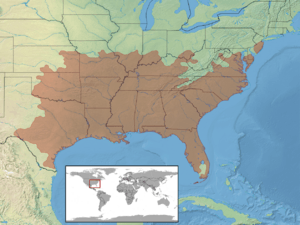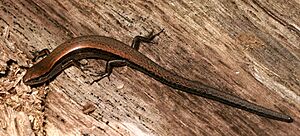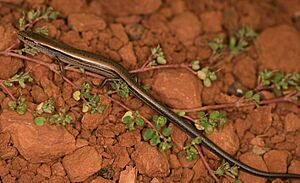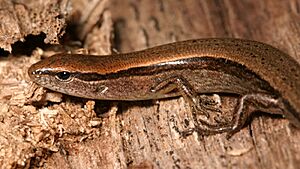Scincella lateralis facts for kids
Quick facts for kids Scincella lateralis |
|
|---|---|
 |
|
| Conservation status | |
| Scientific classification | |
| Genus: |
Scincella
|
| Species: |
lateralis
|
 |
|
| Synonyms | |
|
|
The Scincella lateralis, also known as the little brown skink, is a tiny lizard. It is a type of skink, which is a kind of lizard. You can find this small reptile in the eastern half of the United States. It also lives in northern Mexico.
Contents
- What are the common names for this skink?
- What does the little brown skink look like?
- Where do little brown skinks live?
- What kind of habitat do they prefer?
- How do little brown skinks behave?
- What do little brown skinks eat?
- What animals prey on little brown skinks?
- Reproduction and life cycle
- Are little brown skinks endangered?
What are the common names for this skink?
This skink has a few common names. People often call it the little brown skink. Another common name is the ground skink. However, "ground skink" can also mean other types of skinks in the Scincella family.
What does the little brown skink look like?
The little brown skink is one of the smallest reptiles in North America. It grows to be only about 3 to 5.5 inches long. This measurement includes its tail. Its back is usually a shiny coppery brown color. Its belly is white or yellow.
Like most skinks, it has a long body and short legs. A cool feature is its clear lower eyelids. These allow the skink to see even when its eyes are closed!
Where do little brown skinks live?
The ground skink lives in many parts of the Eastern United States. You can find it from New Jersey and Ohio all the way south to Texas and Florida. It also lives in northern Mexico. These skinks do not live in the higher parts of the Appalachian Mountains.
What kind of habitat do they prefer?
Scincella lateralis can live in different places. They like deciduous forests, which have trees that lose their leaves. They also live in mixed forests with both deciduous and coniferous (cone-bearing) trees. You might find them near hedgerows or at the edges of streams and ponds. They need a deep layer of material on the ground. This could be something like fallen leaves.
How do little brown skinks behave?
The ground skink spends most of its time underground or hidden. It often buries itself in leaf litter on the forest floor. Unlike some other skinks, it does not usually climb trees. It moves by wiggling through the leaves. It uses wavy body movements to get around.
If it feels threatened, it might dive underwater. However, it usually tries to stay away from wet areas. These skinks are mostly active during the day. This is called being diurnal. But they can also be active at night sometimes. They hibernate during the coldest months. Yet, in places like North Carolina, they can be active almost all year. A single skink's home area can be as small as 20 square meters.
What do little brown skinks eat?
The little brown skink eats small creatures. Its diet includes tiny insects and spiders. It also eats other arthropods, like isopods (also known as pill bugs or sow bugs).
What animals prey on little brown skinks?
Ground skinks are a food source for many animals. Snakes like the Eastern racer, Ring-necked snake, and scarlet kingsnake hunt them. Birds that live in woodlands also eat them. These include the barred owl and the red-shouldered hawk. Even the eastern bluebird has been seen eating these tiny lizards.
Reproduction and life cycle
Female Scincella lateralis skinks are ready to have babies when they are about one year old. They lay small groups of eggs. These groups, called clutches, usually have 1 to 6 eggs. Most often, there are 2 or 3 eggs.
The female skink lays her eggs in moist soil. She might also choose rotting logs, fallen logs, or under rocks. Eggs are laid during the summer months. In the Southern United States, this is from March through August. A female skink might lay more than one clutch of eggs in a year. Unlike some other skink types, the female ground skink does not stay to guard her eggs. The eggs hatch in about one to two months.
Are little brown skinks endangered?
The little brown skink is a common species. It is found in many places and is not considered endangered. It is only a conservation concern at the very northern edge of its range. You can see them in grasslands or forests.
- Species Scincella lateralis at The Reptile Database








